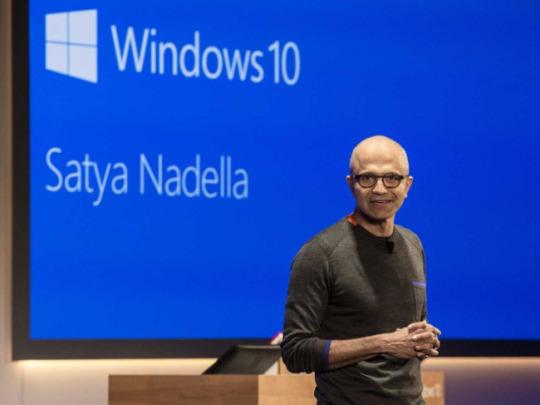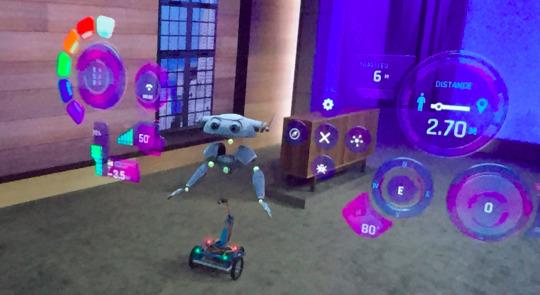Today at Microsoft’s annual developers conference, Build 2015, CEO Satya Nadella revealed the company’s strategy to several thousand avid .NET and Win32 app developers.

Microsoft CEO Satya Nadella. (Photo: Yahoo Finance)
In a bladder-challenging three-hour keynote presentation, a team of Microsoft executives outlined what the software giant has in store for cloud computing, Microsoft Office, Windows 10, and its groovy new HoloLens augmented-reality headset.
“We want to move our users from needing Windows to choosing Windows to loving Windows,” Nadella said.
Here are 10 quick takeaways from Build.
1. The new Windows 10 browser finally has a real name.
What Microsoft had been referring to as “Project Spartan” now has an official name: Microsoft Edge. Tech journalists may now safely retire all references to 300 and introduce new metaphors involving soap operas and “cutting-edge” technology.
Internet Explorer will still exist in Windows 10 for compatibility with websites that need it in order to function correctly, but Edge will be the primary way Microsoft diehards surf the Web.
2. And it’s going to party like it’s 1999.
Edge will have Cortana built in, so you’ll be able to search by asking the Microsoft minx questions. It will accept pen input for annotating webpages (though we’re not exactly sure how or why you’ll use this), and the homepage will feature recommended apps, videos, and sites. From where we were sitting, Microsoft Edge looked an awful lot like a Web portal from the late 1990s. So maybe not so cutting-edge.
3. The HoloLens is even more wicked cool than we thought.
The 3D-augmented-reality glasses that Microsoft’s Alex Kipman introduced to much fanfare last January have gotten even cooler, if that’s possible. On stage, a Microsoft demonstrator used an untethered HoloLens unit to walk through a virtual living room that looked not entirely unlike a 3D version of Microsoft Bob.
Photo: Business Insider/Microsoft Build
Among other cool tricks, HoloLensers will be able to run normal Windows 10 apps literally anywhere and control them using hand gestures; they’ll also be able to “pin” their calendar or a video screen to the walls of the room or have it follow them as they walk around. Note that Microsoft demo’d this in a room largely devoid of actual furniture, thus avoiding any trip-and-fall lawsuits.
4. And will introduce another obnoxious term of art: The Airtap.
To control items wearing the HoloLens, you use a hand gesture called an “airtap” — as in, “Airtap the virtual HD display floating on the wall in front of you to launch a video.” Don’t worry, you’ll get used to it.
5. But it will still be a long time before you’ll be able to buy one.
Kipman said Microsoft brought “hundreds” of untethered HoloLens computers to the Build conference to whet developers’ appetites for the technology. And it demonstrated how the HoloLens can be used to teach anatomy, design buildings, study art, interact with real physical objects, and much more.

HoloLens can be used with a 3D anatomy app. (Photo: Dan Tynan/Yahoo Tech)
So far, though, Microsoft has yet to announce when a software development kit might be available that will allow anyone to build apps for the device, let alone possible pricing or commercial availability.
6. Office is going to get a lot smarter.
Microsoft is turning its flagship suite of productivity software into a platform. This means developers will be able to build apps that plug into Excel, Word, and the like and automatically pull in data from different sources. On stage, Microsoft demonstrated an add-in from Uber that reminds you to call for a ride with enough time to make your next meeting; the app automatically grabs your current location from Windows Maps and your destination from Outlook. Slick.
7. Windows is going to get a lot pushier.
Microsoft’s Joe Belfiore touted the personalization aspects of Cortana, which will constantly be watching what you’re up to and suggesting new apps for you to download, based on the ones you already use. It will also watch how you use your tablet and periodically suggest new things to try, such as using a stylus. There was no word whether you’d be able to turn off any of these features.
8. Your favorite Android and iOS apps may be coming to Windows — finally.
Microsoft announced a handful of tools that will make it easier for developers to take existing iOS and Android apps and port them over to Windows. This means that Microsoft’s anemic apps store may fill up faster; it will also likely enable you to run iOS and Android apps on your Windows 10 desktop or laptop.

Using HoloLens to layer a virtual robot head on top of an actual bot’s body. (Photo: Dan Tynan/Yahoo Tech)
9. Your Windows 10 apps will now run on virtually any device.
One of the key developments pushed at Build is “universal apps” — the fact that Microsoft is using one code base for all Windows platforms moving forward. That means the software that runs on your PC will also run on your phone, tablet, and other devices.
10. One day, your phone could be your only computer.
Once the same code is running on all your Windows devices, it won’t matter which one you use anymore. Belfiore demonstrated a scenario where a person hooks a Windows phone to a full-size keyboard, mouse, and big screen display, and manipulates a PowerPoint presentation that’s identical to one that would normally be edited using a desktop or laptop PC.
What this also means: If you lose your phone, you’re really going to be screwed.
No comments:
Post a Comment